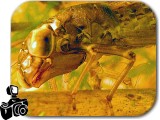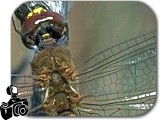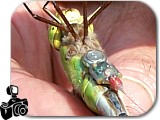| |
| 
 All
of Manitoba’s dragonflies are year-round residents,
but no adults survive over winter. Many insects can survive
freezing, even to -40 C, but dragonflies cannot. The eggs
of certain species, some of the Spreadwing Damselflies (Lestes
spp.) and some Skimmers (Sympetrum spp.), can survive freezing,
even out of water, so they can breed in small ponds that
freeze solid or dry up over winter. All
of Manitoba’s dragonflies are year-round residents,
but no adults survive over winter. Many insects can survive
freezing, even to -40 C, but dragonflies cannot. The eggs
of certain species, some of the Spreadwing Damselflies (Lestes
spp.) and some Skimmers (Sympetrum spp.), can survive freezing,
even out of water, so they can breed in small ponds that
freeze solid or dry up over winter.
The rest of our species pass winter as
nymphs in unfrozen water bodies. Some nymphs can survive
exposure to temperatures as low as -5C, and can even live
a short while encased in ice, but at these temperatures
their body tissues do not actually freeze.
|
|  Nymphs of most Manitoba species overwinter
at least once. Many species take more than one year to grow
to full size. The further north you go in Manitoba, the
shorter summers are, and the longer it may take for nymphs
to reach full size and emerge as adults. Species that grow
to full size in one year in southern Manitoba may take 2
or more years in the far north.
Nymphs of most Manitoba species overwinter
at least once. Many species take more than one year to grow
to full size. The further north you go in Manitoba, the
shorter summers are, and the longer it may take for nymphs
to reach full size and emerge as adults. Species that grow
to full size in one year in southern Manitoba may take 2
or more years in the far north.
|

 Migration
in dragonflies is not well studied. Most dragonflies do
not fly great distances as adults. So they are often attracted
back to the water body where they emerged. Occasionally,
when local dragonfly populations are very high, large groups
of adults will fly long distances and colonize new breeding
habitat. These one-way mass migrations, have been noted
in species such as the Four-Spotted Skimmer (Libellula quadrimaculata)
and Wandering Glider (Pantala flavescens). Migration
in dragonflies is not well studied. Most dragonflies do
not fly great distances as adults. So they are often attracted
back to the water body where they emerged. Occasionally,
when local dragonfly populations are very high, large groups
of adults will fly long distances and colonize new breeding
habitat. These one-way mass migrations, have been noted
in species such as the Four-Spotted Skimmer (Libellula quadrimaculata)
and Wandering Glider (Pantala flavescens).
|
In addition to these occasional mass
migrations there may be a dozen or more species in North
America that have seasonal migrations. In the simplest case
these may be a northerly spread of adults as spring and
summer advance northward each year. However, at least one
species of dragonfly, the Common Green Darner (Anax junius),
has a well defined north-south migration, somewhat like
the Monarch butterfly. Adults emerge in the southern United
States in the spring and fly north reaching the northern
US and southern Canada in late spring. Females lay eggs
as they arrive. The nymphs grow rapidly and adults emerge
by early autumn and fly south. They will lay eggs in the
southern US and their young will emerge the following spring.
Like Monarchs, the species migrates, though no one individual
makes the round trip. Just to confuse things though, there
are also resident northern populations of Common Green Darners
that do not migrate. |
|  Recent
studies of radio-tagged Common Green Darners during
migrations show individuals can fly up to 140 km a
day! Recent
studies of radio-tagged Common Green Darners during
migrations show individuals can fly up to 140 km a
day!
|
|
|   In
eastern North America, fall migrations of Kestrels
(Falco sparverius) sometimes follow the southward
migration of Common Green Darners. Concentrations
of these large dragonflies provide an abundant food
source for these small falcons. In
eastern North America, fall migrations of Kestrels
(Falco sparverius) sometimes follow the southward
migration of Common Green Darners. Concentrations
of these large dragonflies provide an abundant food
source for these small falcons.
|
|
|

Fly back to NatureNorth.com |
|
| |
|